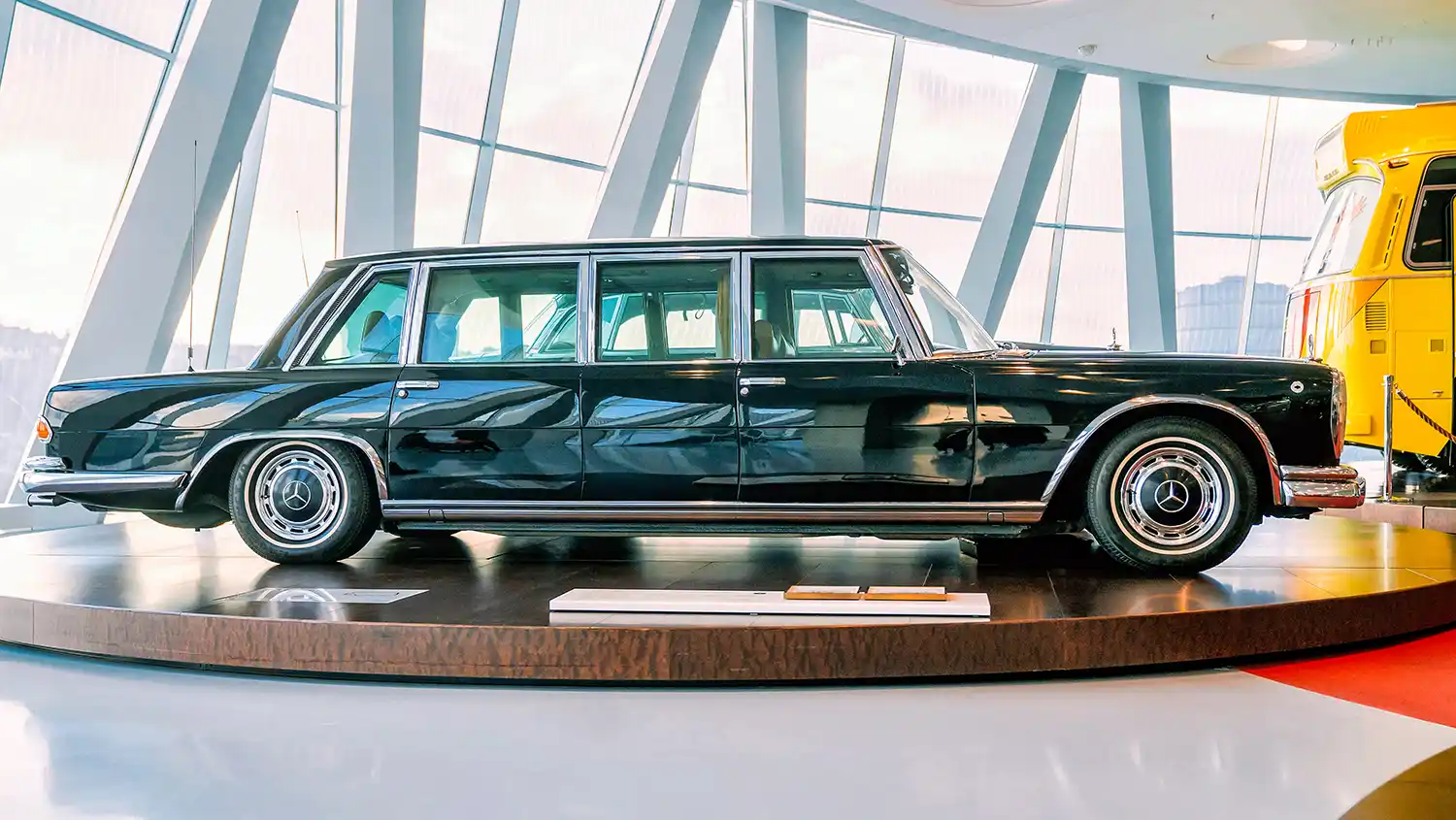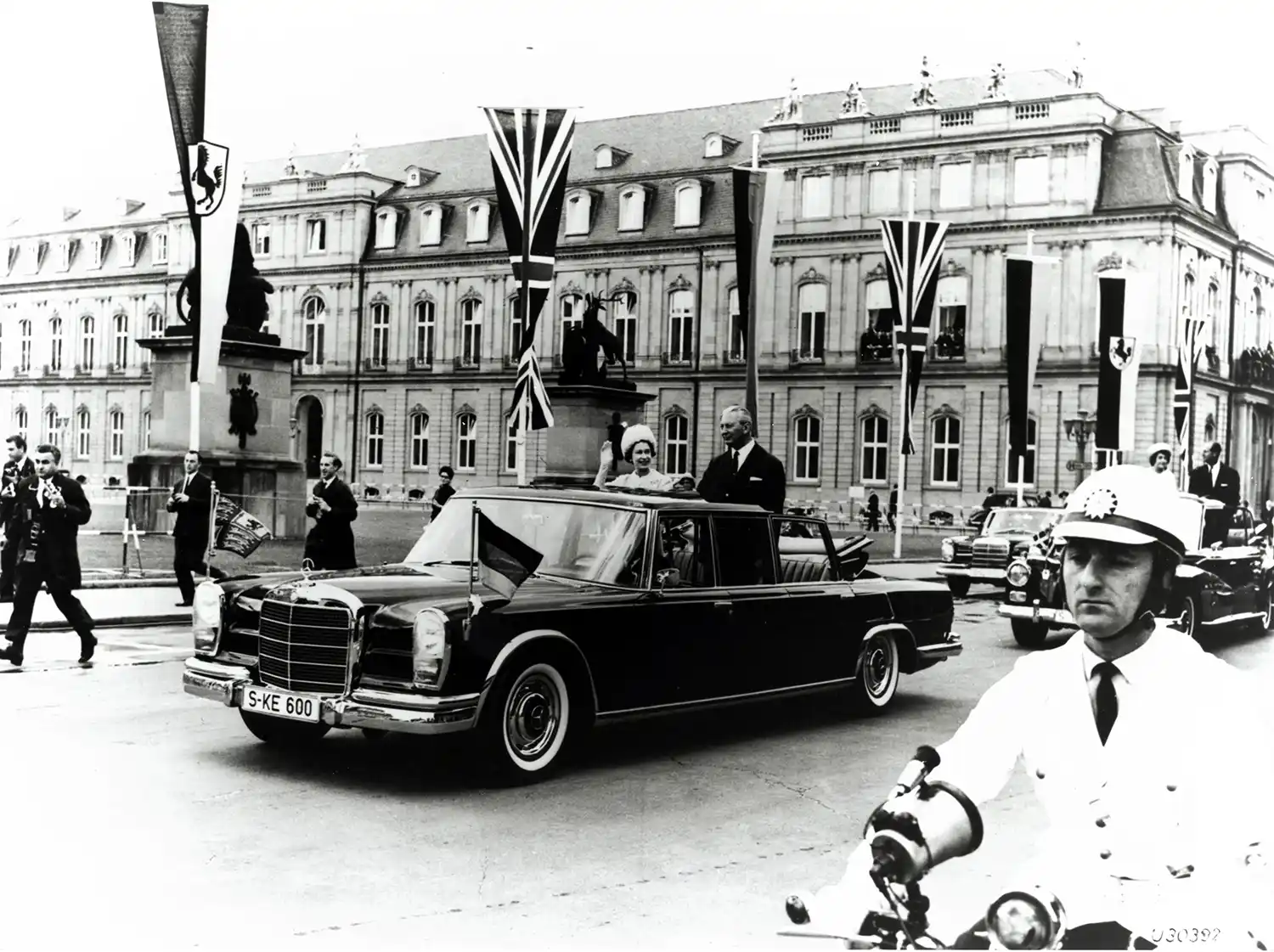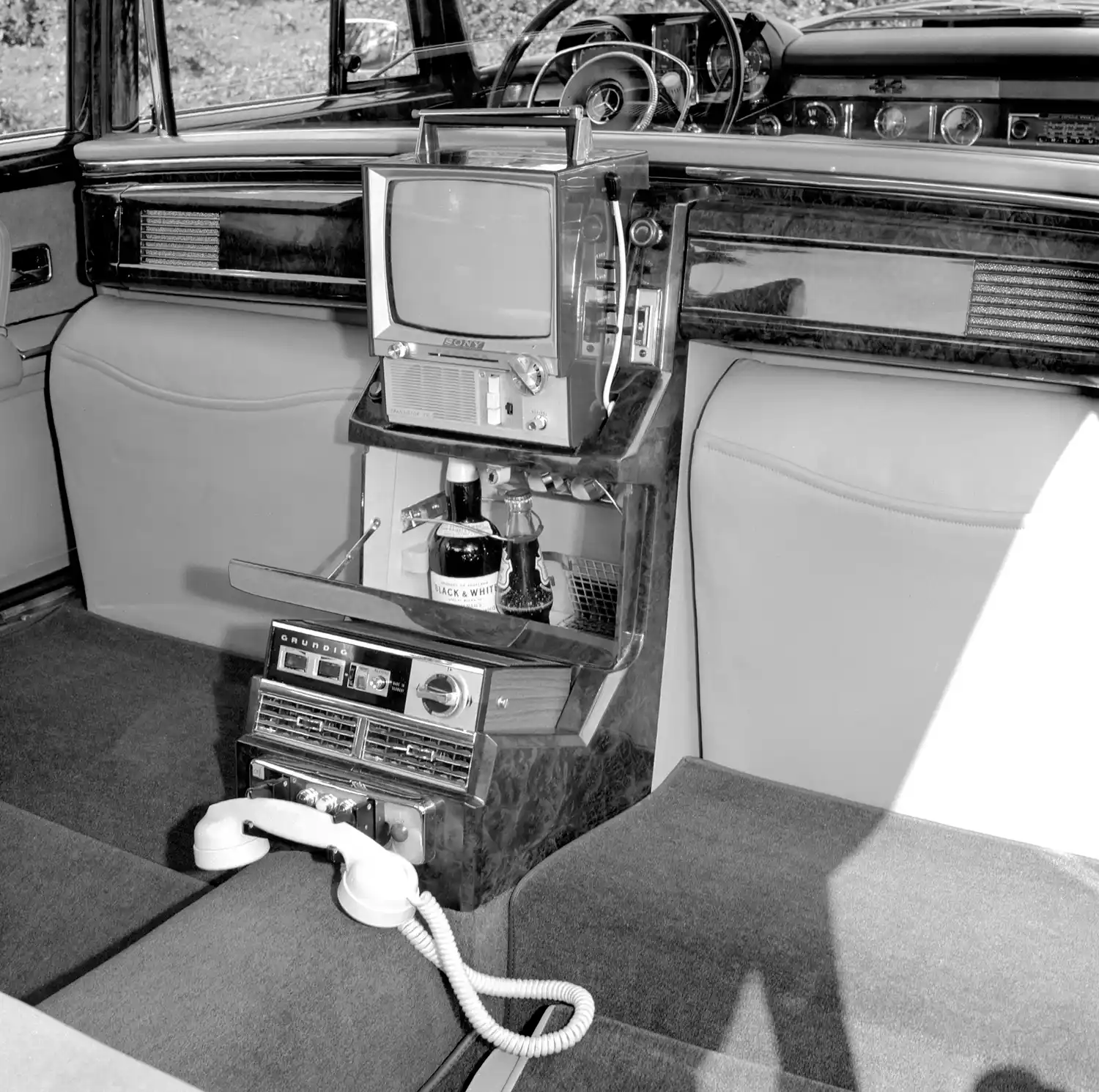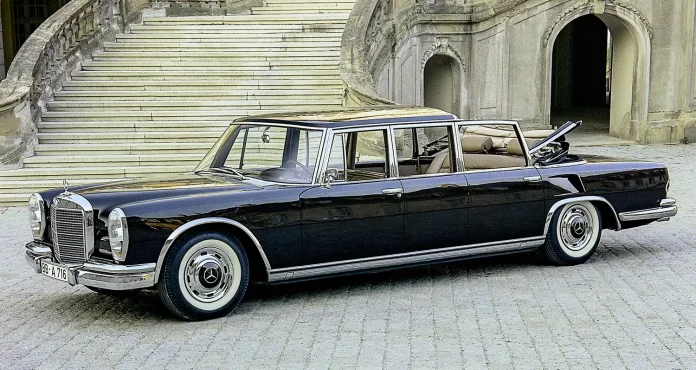
“The ‘Grand Mercedes’ 600 – The exclusive vehicle of great prestige.” With this headline, the 1963 press release for the premiere of the Mercedes-Benz 600 positioned the vehicle with the internal model series designation W 100 right at the very front of the top group worldwide in the industry. 60 years ago, the document went on to describe: “Mercedes-Benz continues the company’s pre-war tradition of being represented in the small group of the world’s sensational prestige cars with a luxuriously equipped automobile that is extremely safe to drive.”
The Mercedes-Benz 600 can be experienced in many ways in the anniversary year: Mercedes-Benz Classic will be exhibiting the legendary series at the Studio Odeonsplatz in Munich from 11 April 2023. The saloon is staged there in the futuristic ambience of the 1960s and its “space age” era. The “Grand Mercedes” will be making another appearance in 2023 at the world’s largest classic car fair, the Techno Classica in Essen, from 12 to 16 April 2023. Even beyond the anniversary year, visitors can see a very special model at the Mercedes-Benz Museum in Stuttgart: the permanent exhibition includes an armoured Mercedes-Benz 600 Pullman state limousine from the company’s fleet, built in 1965. Visitors can find it in the “Collection 4 – Gallery of Names” room. The 600 is even coming home to subscribers of the Mercedes-Benz Classic Magazine – the representative saloon not only adorns the cover; the next issue, which will be published on 12 May 2023, will be devoted in detail to the anniversary vehicle.
An extraordinary automobile for extraordinary celebrities
The “600” held its position as the international benchmark of the automotive top class for almost two decades – until the end of the 17-year production period in 1981. This position was ensured by outstanding technology, exquisite comfort, excellent handling and a more than impressive appearance. The buyers of the prestige limousine came from all over the world. They included royalty, heads of state and celebrities from industry and show business. The vehicles of the W 100 series were produced in the Sindelfingen factory. Mercedes-Benz implemented individual and unusual customer wishes, provided they did not change the basic character of the automobile or come at the expense of safety. This gave each of the 2,677 Mercedes-Benz 600s built, 487 of them the Pullman version, the character of a unique model. Many became collectors’ items after their period of use.
Highly prestigious automobiles are deeply rooted in the origins of the brand. One early example is the Mercedes-Simplex 60 hp, presented in 1903. The top model of the time exists in the Mercedes-Benz Classic collection as a very special exhibit: as an elegant and luxurious touring car from the estate of Emil Jellinek, who shaped and decisively influenced the early days of the Mercedes brand, not only by giving it its name. In the years that followed, the sales programme of the Mercedes and Benz brands always included several models in the highest sphere of automobility. Daimler-Benz AG, arising in 1926 from the predecessor companies, effortlessly continued this tradition, for example, with the 770 “Grosser Mercedes” (W 07 and W 150). From 1951, the company picked up where it left off with the 300 (W 186 and W 189) before the Mercedes-Benz 600 became the new benchmark of automotive excellence. After the end of production in 1981, the company offered Pullman versions of the S-Class to its highly discerning clientele, as well as the Maybach (model series 240), which was manufactured in the Sindelfingen factory from 2002 to 2012. Since 2014, the name Mercedes-Maybach has stood for the most exclusive and prestigious vehicles of the Mercedes-Benz Group.

Four body variants were available
The Mercedes-Benz 600 was produced from September 1964. From the outset, the saloon with a normal wheelbase of 3,200 millimetres and the Pullman Saloon with 3,900 millimetres were offered. There were special protection versions of both from 1965 onwards. Later, the Pullman Landaulet and Pullman Limousine body versions with six doors were added. Most Mercedes-Benz 600s, 743 vehicles, were delivered to the USA. This was followed by Germany with 589, France with 151 vehicles and Great Britain with 126 vehicles. Two special custom-made models were a long-wheelbase Landaulet for Pope Paul VI and a short-wheelbase Landaulet for Count Berckheim. A two-door coupé built in Sindelfingen in 1965 remained a one-off. It served to examine the potential of a large coupé as the successor to the 300 Sc (W 188 II).
The 1964 price list quoted DM 56,500 for the saloon and DM 63,500 for the Pullman Saloon. By comparison, the posh luxury-class saloon Mercedes-Benz 300 SE long (W 112) with automatic transmission cost DM 27,800. The Mercedes-Benz 600 appeared on the price list for the last time in 1979. Now the saloon cost DM 144,368, the Pullman Saloon DM 165,760 and the six-door Pullman Limousine DM 175,728. Here, too, a comparison: the high-performance saloon Mercedes-Benz 450 SEL 6.9 (model series 116) was available in 1979 for DM 78,999.20.
Key data for an outstanding automobile
The concept of the 600 took shape eight years before its world premiere. In the middle of 1955, chief engineer Fritz Nallinger defined the key data for construction group C, for the “future group of large touring and prestige vehicles”. Nallinger described this upcoming prestige car like this: “It gets automatic transmission, power-assisted steering and power-assisted brakes as standard. It is normally a six-seater. The frame floor system is designed to allow for creating a vehicle with three rows of seats by extending the wheelbase, if necessary.”
The car was powered by a V8 engine, the first in a Mercedes-Benz passenger car. The first specimen ran on the test bench at the end of 1959. The production engine, designated M 100, was ultimately given a displacement of 6.3 litres and produced 183 kW (250 hp). It was also used in the Mercedes-Benz 300 SEL 6.3 (W 109) with unchanged power output.
Iconic design and unparalleled comfort
The design of the Mercedes-Benz 600 was created under the direction of Friedrich Geiger. Paul Bracq played a major role. Chief Technology Officer Prof Fritz Nallinger was intensively involved in the design of the new top product from Mercedes-Benz during development. The design made it clear that the vehicle was aimed at special individuals as customers: the exterior was a modern statement of prestige. Inside, passengers could expect an atmosphere of cultivated luxury and distinct culture that made the most of every opportunity to enhance comfort.
At the end of the 1950s, a large vehicle body or good driving performance were not the only unique selling points for a “Grand Mercedes”. More was expected from a Mercedes-Benz. The brand rose to the challenge of making the impossible possible. Werner Breitschwerdt, who later became Chairman of the Board of Management, said in retrospect about the Type 600 at the end of the 1980s: “At the time, we wanted to build a car that could do everything that was possible, and we wanted it to be able to do more than any other car, for the driver and the passenger.”

The ease of use was exemplary. A comfort-class hydraulic system was used for the following functions: closing the doors (comfort closing); sliding sunroof drive; window lifts; partition wall operation; boot operation; opening and closing the heating and ventilation flaps; front and rear seat adjustment; shock absorber adjustment; parking brake release. To achieve the optimum, the engineers compared an electrical system, developed by Breitschwerdt, with a hydraulic system, designed by Ernst Fiala. Hydraulics won. Breitschwerdt on this: “You couldn’t have accommodated the many functions we wanted to do with the electrics back then. It was a space and weight problem because we would have needed a second battery, among other things. With its high pressures, the high-pressure hydraulics developed had the advantage of getting by with small elements. The hydraulics were just smaller, quieter and lighter than electrical systems of the time.”
Head of passenger car development Rudolf Uhlenhaut set three focal points for this modern, prestigious vehicle in a class of its own: the highest passenger comfort, maximum safety and outstanding driving performance. The merging of the air suspension with the front wishbones and the single-joint swing axle with additional lowered thrust arms with braking torque support as well as two cross struts and double suspension in conjunction with the adjustable shock absorbers led to handling that was euphorically rated at the time. The engineers devoted special attention to the brake system. The 600 model had dual-circuit disc brakes at the front and rear. Two brake callipers acted on each of the front 291-millimetre discs. The cross-ply tyres of size 9.00 x 15 were specially designed tyres from Fulda and Continental for the prestige saloon.
The Cd value of 0.458 is astonishingly good for the angular 600. By comparison, the Mercedes-Benz 230 SL “Pagoda” (W 113) with hardtop achieved Cd = 0.515 and the 190 SL model (W 121) with hardtop achieved Cd = 0.461. The driving performance was at a high level: the prestige saloon accelerated from 0 to 100 km/h in 9.7 seconds. The top speed was 205 km/h.
Customers and trade press were enthusiastic
The Mercedes-Benz 600 was widely regarded as the best automobile in the world. Many customers used it for years for mobility befitting their status, whether with a chauffeur or themselves at the wheel. The trade press was also extremely enthusiastic. “Motor Revue” 3/1965 is quoted here as a representative example: “The result is a level of ride comfort that is undoubtedly the optimum achieved in automobile engineering to date.” And sums up: “You can […] drive the 600 on mountain passes like a sports car – a well-driven sports car then has a very hard time keeping up.”












The post Mercedes-Benz 600 “Grand Mercedes – W 100” (1964) appeared first on Wheelz.me-English.




